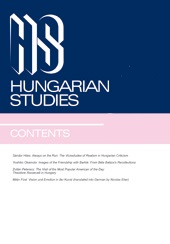Die ungarische Tanzhaus-Bewegung. Ein Beispiel für Volkskultur in der Moderne
The Hungarian dance house movement. An example of folk culture in the modern age
Author(s): Julia HellSubject(s): Theatre, Dance, Performing Arts, Customs / Folklore, Music, Civil Society, Social history
Published by: Akadémiai Kiadó
Keywords: Hungary; Socialism; Cultural policy; Dance house; Popular culture; Folk music; Folk dance; folklorism; Mesh;
Summary/Abstract: A typical dance house evening is characterized by an exuberant mood among young people, a sense of community and active participation in the reproduction of folk music and folk dance. Young intellectuals, in particular, were dissatisfied with the state-directed "socialist folklore" in their own way with Hungarian folk culture. Since the first event in 1973, the Hungarian dance house has evolved from a partially politically motivated movement to a dance scene, which is today firmly established in the Hungarian entertainment culture. In modernity characterized by progressive thinking and fast-moving modernity, Tanzhaus enthusiasts consciously draw on the goods of Hungarian folk culture. Thus, a novel, experimental exploration of traditional music and the corresponding dances is promoted. The Hungarian dance house as a retro-culture unites the traditional with the new and thus represents a form of folk culture care adapted to modern requirements. Thus, the special role of the Tanzhaus movement and of today's dance scene for popular culture in the modern age is that at the events Folk culture is not something past or perishing, but something present.
- Issue Year: 23/2009
- Issue No: 2
- Page Range: 223-246
- Page Count: 24
- Language: German
- Content File-PDF

